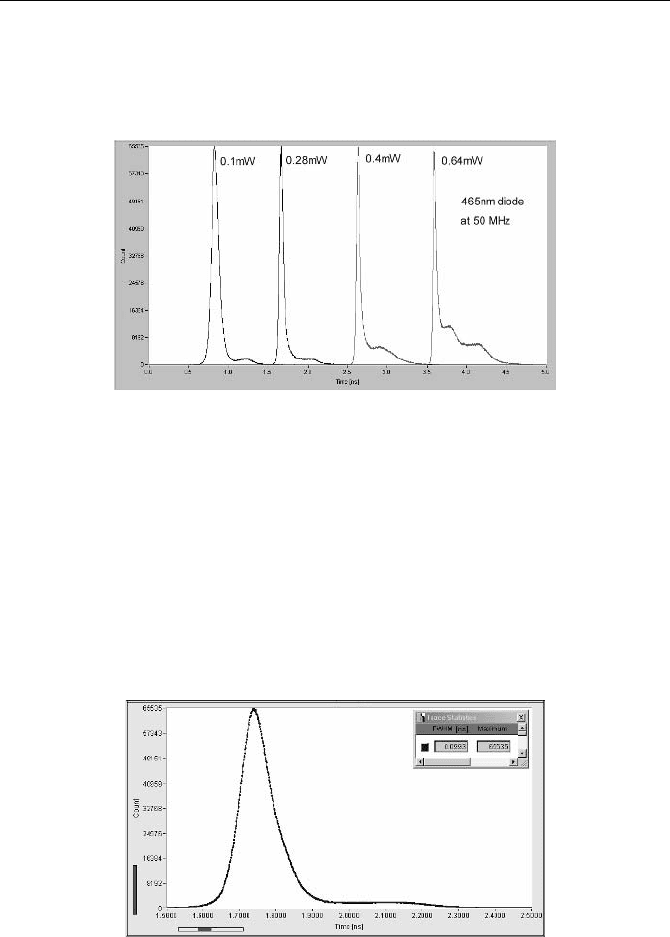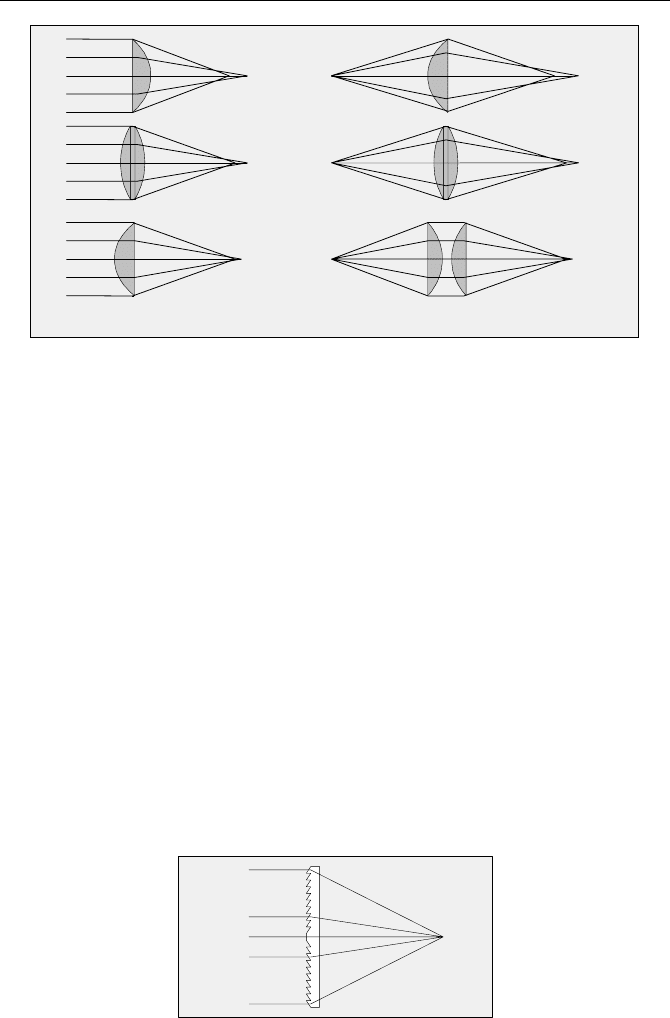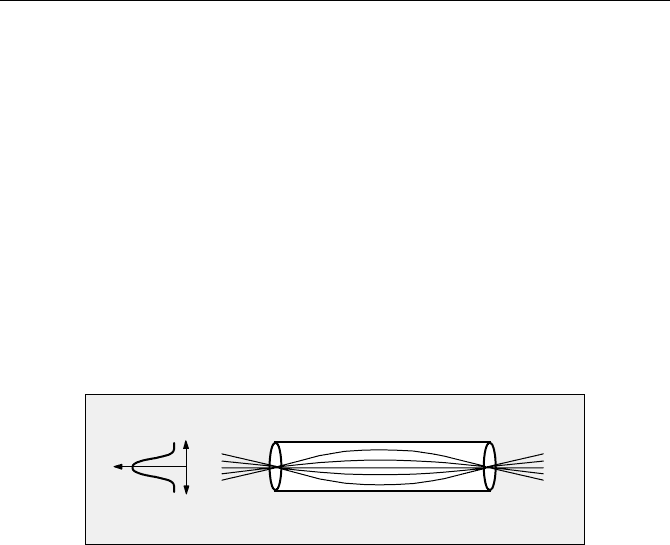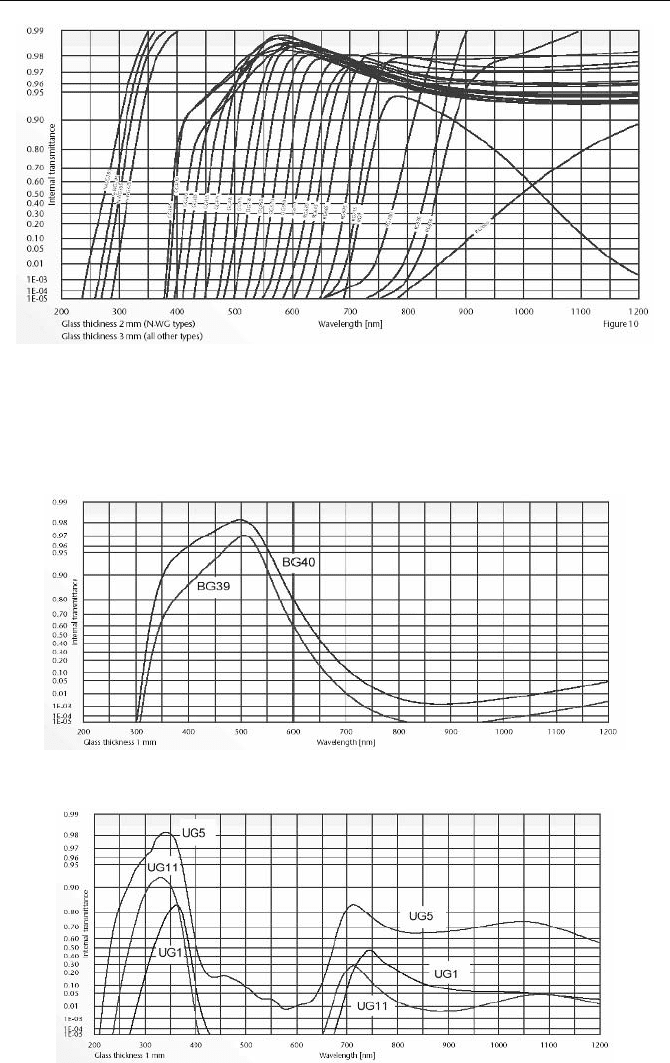Becker W. Advanced Time-Correlated Single Photon Counting Techniques
Подождите немного. Документ загружается.


7.1 Excitation Sources 265
be obtained from a given laser diode is much lower for picosecond pulses than for
continuous operation.
The pulse shape obtained from diode lasers changes with the power. Typical
pulse shapes are shown in Fig. 7.2.
Fig. 7.2 Pulse shape of a 465-nm laser diode at different powers. Repetition rate 50 MHz,
curves recorded by MCP-PMT and TCSPC, time scale 500 ps/div. Pulse width (FWHM),
corrected for 30 ps TTS of MCP-PMT: 100 ps, 50 ps, 46 ps, and 42 ps
At a power close to the laser threshold, the pulses are relatively broad. With in-
creasing power the pulse width decreases. Finally a tail develops, or afterpulses
appear. Therefore, the power setting of the laser should not be used to control the
count rate of a TCSPC experiment. In particular, the power should not be changed
during a series of measurements or between a fluorescence and an IRF recording.
Sub-ns pulses in the red and NIR region can be generated by connecting a small
laser diode to a fast pulse generator. An example for a 650 nm, 5 mW diode con-
nected to a HP 3181A pulse generator is shown in Fig. 7.3.
Fig. 7.3 Light pulse of a 650 nm, 5 mW laser diode driven by pulses of 4.3 V amplitude
and 1 ns duration from a HP 3181A pulse generator. Time scale 100 ps/div. The pulse was
recorded by an R3809U MCP and an SPC830 TCSPC module. The FWHM of the light
pulse is about 100 ps

266 7 Practice of TCSPC Experiments
Provided that the pulse generator already exists, this is certainly the cheapest pi-
cosecond light source ever used. Of course, operating a laser diode this way is most
likely not in compliance with any laser safety regulations. In addition, RF emission
can be a problem if the diode and the driving generator are not properly shielded.
A remark appears indicated about the measurement of the power of a picosec-
ond diode laser. The sensor in power meters for the 10 µW to 10 mW range is
usually a silicon photodiode. The photodiode is connected to a transimpedance
amplifier that holds the diode voltage at zero and delivers an output voltage pro-
portional to the diode current. Of course, the amplifier is far too slow to react to
the fast diode laser pulses. Consequently, the pulses bias the diode in a forward
direction. The result is a logarithmic dependence of the voltage on the input
power. At a 50 MHz repetition rate, the linearity error usually becomes noticeable
above 1 mW average power and can easily reach 100% at 5 mW. The problem can
be avoided by operating the photodiode with a reverse bias. It is normally not
known whether a particular power meter uses a biased or an unbiased photodiode.
Titanium-Sapphire Lasers
An almost ideal, though expensive, light source is the Titanium-Sapphire
(Ti:Sapphire) laser. The benefit of the Ti:Sapphire laser are its short pulse width
and its tunability. Depending on the version of the laser and the pump power,
tunability from 700 to 980 nm can be achieved. The pulse width is a few picosec-
onds for picosecond versions and about 100 fs for femtosecond versions. Lasers
with less than 20 fs pulse width are available.
The first Ti:Sapphire lasers needed some fine-tuning to obtain stable pulses, es-
pecially when the wavelength was changed. The pulse stability had to be checked
by a photodiode and the pulse width by an autocorrelator. For the past few years,
computer controlled self-adjusting Ti:Sapphire lasers have been available. These
lasers do not need manual alignment.
Their high power, high stability, excellent beam quality and short pulse width
make the Ti:Sapphire laser excellently suited for both direct NIR excitation and
two-photon excitation. Light in a wide spectral range can be obtained by continuum
generation in a photonic crystal fibre. To obtain pulses in the visible and UV region,
the fundamental wavelength can efficiently be frequency-doubled or tripled. The
gap between the fundamental and the SHG is sometimes closed by pumping an
OPO (Optical Parametric Oscillator) and SHG from the OPO output. Such systems
are, of course, very expensive and need some maintenance and alignment.
The repetition rate of Ti:Sapphire lasers is fixed by the resonator length. Rates
from 78 to 92 MHz are common. The high repetition rate helps to minimise
classic pile-up effects in TCSPC measurements. However, it can cause problems if
fluorescence lifetimes longer than 3 or 4 ns have to be measured, since the fluo-
rescence does not decay completely within the pulse period. Data analysis can
account for incomplete decay to a certain degree. However, if the lifetime be-
comes equal to or longer than the pulse period, the accuracy of the obtained life-
time degrades. The pulse repetition rate must therefore be reduced by a pulse
picker.

7.1 Excitation Sources 267
Unfortunately, pulse pickers have some severe drawbacks. One is that the
minimum rate reduction factor is about 10. Repetition rates around 40 or 20 MHz
are thus not available. Moreover, there is a leakage in the intermediate pulses of
the order of 1%. For the first suppressed pulse the leakage can be even higher.
Finally, most pulse pickers generate RF noise, which is synchronous with the
pulses and can severely impair the differential linearity of a TCSPC system.
Synchronously Pumped Dye Lasers
Synchronously pumped jet-stream dye lasers are sometimes used to obtain light in
the gap between the Ti:Sapphire fundamental and the SHG. The systems need
permanent alignment and supervision. The pulses of synchronously pumped dye
lasers have a considerable amplitude jitter and amplitude drift, which makes accu-
rate synchronisation of a TCSPC device difficult. Moreover, even the cleanest
systems release some laser dye into the environment, and contamination of sam-
ples with laser dyes is a problem. Dye-flow systems become an even less attrac-
tive option when a hose breaks and spills liters of dye solution on the floor.
Nd-YAG Lasers
Nd-YAG lasers deliver picosecond pulses at a wavelength of 1,064 nm and a typi-
cal repetition rate of 50 to 80 MHz. New laser media emitting at close to the same
wavelength have shown improved efficiency and output power. Due to their high
power and low pulse width, frequency doubling, tripling, and quadrupling work
efficiently. Lasers with integrated frequency multipliers are efficient sources of
high-power UV radiation. The wavelengths fall into the wavelength gaps of the
frequency-multiplied Ti:Sapphire laser. Nevertheless, probably because it is not
tuneable, the Nd-YAG laser is increasingly being replaced by the Ti:Sapphire
laser.
Chip Lasers
The chip laser is actually a miniaturised version of the Nd-YAG laser. It contains
a diode laser pump, an active laser medium, a saturable absorber, and a frequency
multiplier in a solid block. Chip lasers are an inexpensive and reliable source of
UV radiation. Unfortunately they cannot be made with repetition rates higher than
a few tens of kHz. The pulse width is of the order of 1 ns. Chip lasers are some-
times used in TCSPC systems for environmental research, e.g. to trace contamina-
tion of water by polycyclic hydrocarbons.
Fibre Lasers
Fibre lasers deliver femtosecond pulses around 1,600 nm, or at the SHG wave-
length of 800 nm. The power is a few tens of mW, the pulse width about 150 fs, and
the repetition rate about 80 MHz. The power is sufficient for two-photon excitation
in scanning microscopes. Further frequency doubling is possible. Fibre lasers are

268 7 Practice of TCSPC Experiments
reliable and do not need any maintenance. Nevertheless, they do not yet have much
application in spectroscopy, possibly because they are not tuneable. This drawback
may possibly be overcome by continuum generation [106], which delivers funda-
mental wavelengths in the range of 1,150 to 1,400 nm. A light source based on an
Yb:KGW oscillator [111] and a photonic crystal fibre delivered sub
300 fs pulses
at a wavelength tuneable in the range of 950 to 1,200 nm [129].
Synchrotron Radiation from Electron Storage Rings
The synchrotron radiation from electron storage rings has a broad spectrum from
X-ray wavelengths to the IR. When the first storage rings were put into operation,
attempts were made to use the radiation for almost any kind of time-resolved spec-
troscopy. Synchrotron radiation is now comparatively out of favour. Compared to
a laser, the power per nm wavelength is low. The pulse width is longer, and the
optical beam quality is worse. The pulse repetition rate is fixed and usually too
low for high-count rate TCSPC applications. The intensity drops slowly over sev-
eral hours between the successive electron injections. Moreover, there can be a
considerable leakage of the RF field of the storage ring, which can severely impair
the differential linearity of TCSPC measurements.
7.2 Optical Systems
Typical optical systems used for TCSPC collect less than 10% of the photons
emitted by the sample. Consequently, if the detection efficiency is to be increased,
the largest potential is in the optical system, not in the detector or in the TCSPC
module. Nevertheless, TCSPC users are often more willing to spend tens of
thousands of dollars for a detector of a slightly higher quantum efficiency or for a
stronger laser than a few hundred dollars for some good lenses and other high-
quality optical components. However, a good optical system often not only im-
proves the detection efficiency dramatically, but also reduces typical error sources,
such as signal distortion by reflections, pulse dispersion, instability or wavelength-
dependence of the IRF, and leakage of excitation light or daylight.
Optical systems used for different TCSPC applications range from scanning mi-
croscopes over simple lenses and fibre systems without any lenses to camera sys-
tems and telescopes. The light sources and the sample geometry may differ consid-
erably and different wavelength resolutions may be required. It is impossible to
describe all possible variants in detail. The general principles of the optical systems
for the most common applications are described under Chap. 5, page 61. The fol-
lowing section describes optical elements frequently used in the optical part of
TCSPC systems, and gives hints about how to get the best performance from them.

7.2 Optical Systems 269
7.2.1 Lenses
Lenses are certainly the most frequently used optical elements. Unfortunately, a
simple spherical lens yields a very poor focus quality, even if only the beams
parallel to the optical axis are considered. The most important aberrations on the
optical axis are spherical and chromatic aberration. The lens has a different focal
length for rays of different distance from the optical axis, and different focal
lengths for different wavelengths (Fig. 7.4).
Both the spherical and the chromatic aberrations increase dramatically with the
f number or the numerical aperture of the lens. The f number (usually written as
f/#) is defined as
Dff //# (7.1)
with
f = focal length, D = diameter. An f/8 lens has a focal length of 8 times the
diameter. The light collection power of a lens is also described by the numerical
aperture,
NA. The numerical aperture is
I
sin
0
nNA (7.2)
with
n
0
= refractive index of the medium in front of the lens,
I
= angle between
the optical axis and a ray from the edge of the lens into the focus. For small
f numbers and lenses in air, the NA is approximately
#/5.0 fNA , or fDNA /5.0 (7.3)
The absolute size of the aberrations increases with the size of the lens and its
f number. Moreover, oblique beams experience coma and astigmatism, i.e. the
spot where the rays are combined is no longer circular. Moreover, the surface of
best focus is curved.
In TCSPC systems, light is often to be collected from a small spot in a sample
and transferred to a small-area detector, the slit of a monochromator, or an optical
fibre. Most optical systems for TCSPC do not use strongly oblique beams so that
coma, astigmatism, and curvature of the image field are usually not problems.
However, to obtain a high collection efficiency, high f numbers must be used, and
problems arise from spherical and chromatical aberration.
A
B
A
B
Image plane
Image plane
blue red
LensLens
Fig. 7.4 Spherical (left) and chromatic (right) aberration in a lens

270 7 Practice of TCSPC Experiments
Achromatic Lenses
The best solutions to the aberration problem is to use achromatic lenses. Achro-
matic lenses consist of a positive and a negative lens made of glass of different
dispersion and refractive index. The lenses are designed in such a way that both
chromatical and spherical aberration are corrected on the optical axis. Moreover,
astigmatism, coma, and field curvature are reduced, but not entirely corrected.
More than two lenses can be used to correct for off-axis aberrations as well. How-
ever, the correction works only if the lens is used at the conjugate distances for
which it is designed, and in the right orientation. In principle, a doublet or triplet
lens can be corrected for any conjugate ratio. The correction may also compensate
for the aberration of other optical elements, such as prisms in a convergent or
divergent beam. However, general-purpose doublet lenses are usually corrected
for infinite conjugate ratio, i.e. for focusing a parallel beam into a spot or vice
versa. Figure 7.5 shows how achromats corrected for infinite conjugate ratio can
be used to build a relay lens with conjugate foci. Both achromats are used in the
configuration they are designed for. The focal lengths are selected to achieve the
desired transfer distance ratio.
Lens 1 Lens 2
f1 f2
Fig. 7.5 Transfer system for use at conjugate foci made of two lenses corrected for infinite
conjugate ratio. The focal lengths of lens 1 and lens 2 are f
1
and f
2
, respectively
In practice it is sometimes not clear which side of an infinity-corrected doublet
is to be directed toward the convergent or the parallel beam. There is, however, a
simple way to find out. If the lens has a focal length shorter than about 10 cm,
hold the lens with your arm outstretched over a sheet of printed paper or any other
structured plane surface. When the lens is almost focused on the paper, you see a
fuzzy, but strongly magnified image. If the convergent-beam side of the lens is
oriented to the paper, all parts of the lens come into focus simultaneously and you
see a fuzzy but otherwise undistorted image. If the parallel-beam side is oriented
to the paper, you see a distorted image, as shown in Fig. 7.6.

7.2 Optical Systems 271
For a lens of long focal length, such as a telescope objective lens, you can re-
verse the test. Look at a distant object (not the sun) and hold the lens at focal
length of your eye. If the convergent-beam side directs to the eye, the image re-
mains undistorted when the eye is close to the focus.
Normal achromats are made of a crown glass and a flint glass lens. Unfortu-
nately, flint glass becomes nontransparent below about 360 nm. Standard achro-
mats therefore cannot be used in the UV. UV achromats can be made of fused
silica and calcium fluorite. Their high price and low f numbers make them less
useful for TCSPC optics.
Aspheric Lenses
High f numbers and low spherical aberration can also be obtained with aspheric
lenses. Such lenses are available for condensers in projectors or other illumination
purposes. Chromatic aberration remains uncorrected, and the off-axis aberrations
are large. Moreover, aspheric lenses are moulded, not ground as in high-quality
optical elements. They are therefore made from glass or plastic, not from fused
quartz or other UV transparent materials. As achromatic doublets, aspheric lenses
must be used in the right orientation. Usually there is a flat side or a spherical side
of low curvature. If the lens is corrected for infinite conjugate distances, the flat
side must be directed to the convergent beam. You can test them in the same way
as for an achromat.
Single Element Lens Systems
Often the only way to build optical systems for UV is with spherical lenses made
of fused silica („quartz lenses“). Fused silica has a lower index of refraction than
glass, so the curvature of the lenses for a given focal length is stronger and the
spherical aberration is larger than for a glass lens. The aberrations can be mini-
mised (though not removed) by using the proper lens shape. Often, in practice,
only plano-convex and double-convex lenses are available, but even with these the
aberrations can be reduced. A few examples are shown in Fig. 7.7.
Fig. 7.6 Checking an achromatic doublet corrected for infinite conjugate ratio. If the con-
vergent-
b
eam side is directed to the paper the image remains undistorted when the paper
comes close to the focus (left). Otherwise the image is distorted (middle and right)

272 7 Practice of TCSPC Experiments
Flat side
Double convex
Plano convex
2 x Plano-convex
in parallel
convergent
beam
Parallel beam into point
Infinite conjugate distances
Point into point
1:1 conjugate distances
beam
Flat side in
Double convex
Fig. 7.7 Minimising the aberration of spherical lenses for focusing parallel light (left) and at
conjugate foci (right). Aberration decreases from top to bottom
Three examples for focusing a parallel beam are shown at the left side of
Fig. 7.7. A plano-convex lens used at infinite conjugate ratio yields a poor focus
quality if the flat side is on the parallel-beam side. A double-convex lens works
better, but not as good as the plano-convex lens with the convex side directed to
the parallel beam. Three examples for 1:1 conjugate distance are shown right. A
single plano-convex lens gives a very poor focus quality. The double-convex lens
is better. However, two plano-convex lenses with the convex sides facing each
other work better than the double-convex lens. For conjugate ratios other than
1:1 two plano-convex lenses of different focal length can be used.
Please note that these rules apply only to beams parallel to the optical axis. If
off-axis aberration must be taken into account, the optimum lens shapes can be
different. An introduction to basic lens design is given in [252].
Fresnel Lenses
Large-size high-aperture condenser systems in projectors often use Fresnel lenses.
A Fresnel lens is a flat piece of plastic with concentric grooves that act as individ-
ual refracting surfaces (Fig. 7.8).
Fig. 7.8 Fresnel lens

7.2 Optical Systems 273
Fresnel lenses are light, inexpensive, and can be made with large f numbers and
good correction for spherical aberration. Off-axis aberrations are strong, as for
aspheric lenses. Moreover, Fresnel lenses generate an enormous amount of scat-
tered light. Another drawback of Fresnel lenses in TCSPC systems is pulse disper-
sion. In a normal lens the refraction is achieved by bending the wavefront of the
light by the delay in the glass of the lens, which compensates for the different path
lengths outside the lens. In a Fresnel lens the effective path length for rays at the
edge is longer than for rays in the centre.
Gradient-Index Lenses
Gradient-index (or GRIN) lenses are rods of glass having a radially decreasing
index of refraction. Beams tilted with respect to the longitudinal axis are refracted
back to the axis. The length of the rod is selected so that the end faces form conju-
gate image planes (Fig. 7.9).
n
r
-r
Fig. 7.9 Gradient-index (GRIN) lens
GRIN lenses can be used as miniature endoscopes. They are therefore increas-
ingly used in biomedical applications. A GRIN lens can be brought in direct con-
tact with the specimen or even be implanted into the tissue. Although the optical
quality of the lenses is not perfect it is good enough that two-photon microscopy
through the lenses is possible [320].
7.2.2 Filters
Filters are used to select a special emission wavelength, to suppress excitation
light in fluorescence experiments, and to adjust the intensity of a light signal.
Filters can be based on absorption in coloured glass or on reflection and interfer-
ence in a stack of dielectric and metal layers.
Absorptive Glass Filters
A number of commonly used colour filters are shown in the figures below. It re-
quires a long-pass filter to suppress the excitation light in fluorescence experi-
ments with one-photon excitation. A large number of long-pass glass filters of
different cut-off wavelength are available. Transmission curves of the commonly
used long-pass filter glasses are shown in Fig. 7.10.

274 7 Practice of TCSPC Experiments
Fig. 7.10 Absorptive long-pass filters. [447], Courtesy of Schott, Germany
As can be seen from Fig. 7.10, there is a wide variety of long-pass filters. Unfortu-
nately the situation for short-pass filters is far less favourable. Transmission curves of
glasses that can be used as short-pass filters are shown in Fig. 7.11 and Fig. 7.12.
Fig. 7.11 Absorptive short pass flitters, visible range
Fig. 7.12 Absorptive short-pass filters, UV range, [447] Courtesy of Schott, Germany
